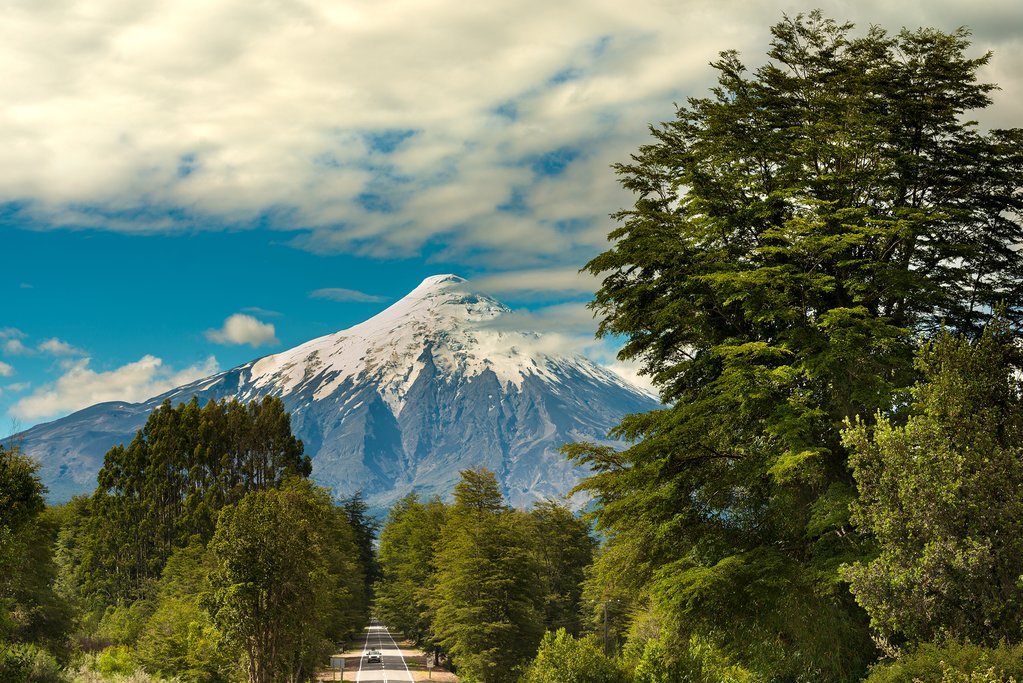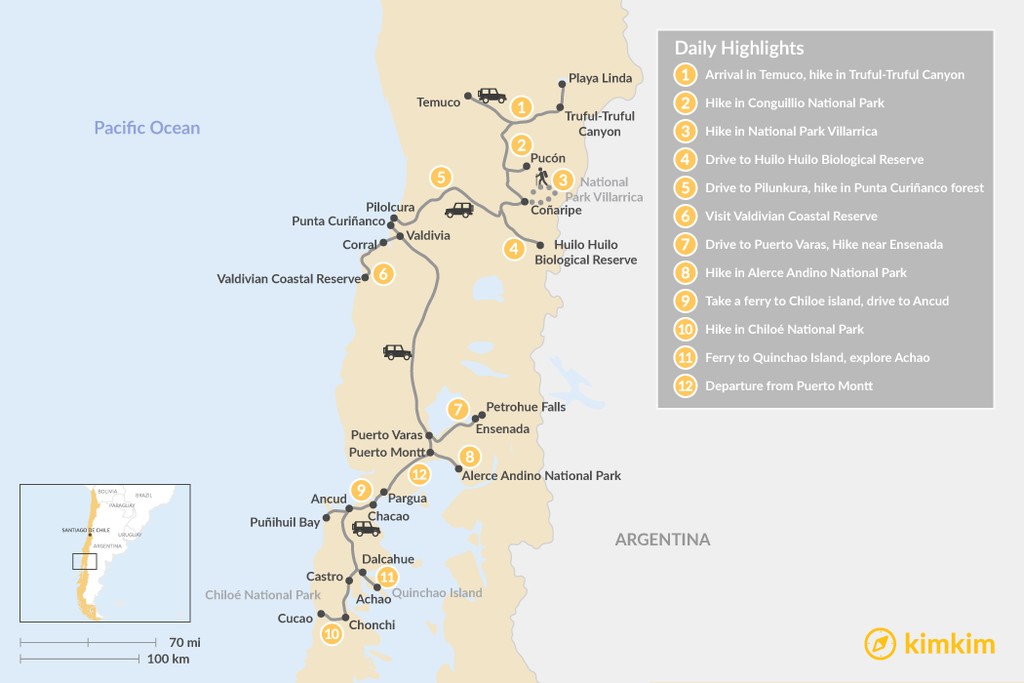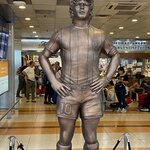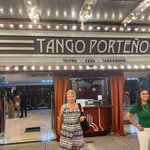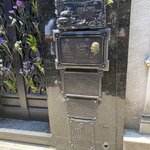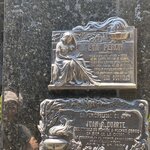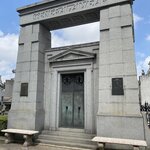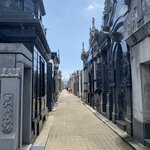Highlights
- Feast on fresh seafood and look for wildlife near Puñihuil Bay
- Relax after a day’s trek in the rejuvenating Geometricas Hot Springs
- Admire the power of Petrohue Falls in Vicente Perez Rosales National Park
- Walk among the treetops on a canopy tour at the Huilo Huilo Biological Reserve
- Learn about healing plants on a guided walk led by indigenous Lafquenche guides
- Photograph the enchanting wooden architecture in the coastal villages of Chiloé
- Hike past the spectacular Pichillancahue Glacier in the Parque Nacional Villarrica
Overview
The 13-day journey begins in Temuco (845 km south of Santiago). After flying in, you’ll pick up your rental car and head south to the Conguillio National Park, where you’ll see waterfalls, an impressive canyon and one massive volcano. You’ll continue south to Pucón, stopping for another memorable hike along the way.
As you make your way south, you’ll hike a glacier trail, soak in hot springs and visit a biological reserve full of wildlife. Making your way west to Valdivia, you’ll walk through lush coastal forests and see 3000-year-old larch trees. Then you’ll head south and east, passing Puerto Varas and Ensenada, en route to yet more stunning national parks—including Vicente Perez Rosales National Park with its snow-covered volcanos and mighty waterfalls.
The road trip continues to Chiloé, where you’ll spend the final few days exploring a fascinating mist-covered island of intriguing wooden villages, untouched coastal stretches and dense forests.
Brief Itinerary
| Day | Highlights | Overnight |
|---|---|---|
| Day 1 | Arrival in Santiago de Chile | Santiago |
| Day 2 | Flight to Temuco - Hike Truful-Truful Canyon | Conguillio |
| Day 3 | Hike in Conguillio National Park - Transfer to Pucón | Pucón |
| Day 4 | Hike in National Park Villarrica - Pichillancahue Glacier Trail | Coñaripe |
| Day 5 | Wildlife Watching in Huilo Huilo Biological Reserve | Huilo Huilo Reserve |
| Day 6 | Walk in Pilunkura - Hike Punta Curiñanco | Valdivia |
| Day 7 | Valdivian Coastal Reserve | Valdivia |
| Day 8 | Hike in Vicente Perez Rosales National Park | Puerto Varas |
| Day 9 | Hike in Alerce Andino National Park | Puerto Varas |
| Day 10 | Boat Trip to Monumento Natural Islotes de Puñihuil | Ancud |
| Day 11 | Hike in Chiloé National Park | Ancud |
| Day 12 | Quinchao Island - Explore Curaco de Velez & Achao | Ancud |
| Day 13 | Flight to Santiago - Departure |
Detailed Itinerary
Day 1: Arrival in Santiago de Chile

Welcome to Chile! Upon arrival at Santiago International Airport, a driver will meet you and transfer you to your hotel. You'll have the rest of the day to explore the city at your leisure.
Suggested activities include:
- Hike to the top of Cerro San Cristobal, where you can get your bearings by surveying the area from a high vantage point. Pathways lead 2,788 feet (850 m) up this central hill to a series of lookouts that offer wraparound views of Santiago. If you aren't the hiking type, not to worry: catch a scenic gondola instead.
- Stroll the cobblestone streets of Barrio Bellavista. On the north side of Santiago, you'll find this trendy enclave, at once fashionable and bohemian. Stroll past colorful houses adorned with graffiti art and choose between an eclectic array of eateries and bars—great for people watching.
- Visit the Plaza de Armas, a stone plaza located in Santiago's historic center dating to 1541. There's also the impressive Catedral Metropolitana, a neoclassical church dating to 1748 whose towering twin bell towers dominate the north side of the plaza.
- Snap pics in front of the Palacio de la Moneda. Chile's opulent Presidential Palace (known simply as "La Moneda") is a short stroll from the Plaza de Armas. It was here in 1973 that Chile's armed forces, backed by the U.S. government, overthrew President Salvador Allende, kicking off a brutal right-wing military dictatorship that would last for 17 years. Visitors are welcome.
For dinner be sure to get out of the hotel and enjoy a culinary adventure in the city. In recent years Santiago has emerged as a global foodie destination. Chilean chefs are reinventing traditional dishes like empanadas, cazuelas (stews), and seafood with ingredients harvested all the way from the northern deserts and southern Patagonian regions. You can find great restaurants and wine bars not only in the Bellavista neighborhood but also in the revitalized historic barrios of Yungay and Italia.
Day 2: Flight to Temuco - Hike Truful-Truful Canyon

After breakfast, transfer to the Santiago airport for your flight south to Temuco, a city in central Chile. This is the former home of Pablo Neruda, one of the most influential poets of the 20th century. Its leafy central square, Plaza Aníbal Pinto, is adorned with imported palm trees, while the nearby Regional Museum of Araucania is a colonial building housing traditional Mapuche costumes and decorative objects, plus archaeological artifacts.
From here, you'll pick up your rental car and set off on the big adventure. You'll drive approximately two hours, passing through old-fashioned towns like Cunco and Melipeuco until reaching Conguillio National Park. This is one of the most spectacular parks of Chile's volcano-filled Lake District.
This UNESCO Biosphere Reserve is best known for the Llaima Volcano (elevation 10,253 ft), one of the largest and most active volcanoes in Chile. You'll walk on lava flows that once came from deep within the earth. You'll also visit the Truful-Truful Canyon and its waterfalls. The colorful strata of this section provide a remarkable record of Llaima's 13,000 years of volcanic activity. Stay overnight in Conguillio.
Day 3: Hike in Conguillio National Park - Transfer to Pucón

On day three, you'll visit Arco Iris (Rainbow) Lagoon, notable for its clear waters that reflect stunning colors. Next, you'll visit Playa Linda, on the shores of Conguillío Lake.
From here, you'll go hiking along the Sierra Nevada trail (a five-hour round trip) surrounded by native trees, including ancient monkey-puzzle trees (araucarias). The trail is a great place to spot endemic birds such as the Magellan woodpecker. You may also spot slender-billed parakeets and the chucao tapaculo, with its distinct orange throat.
After taking in the view, you'll hike back to the bottom of the trail and drive on to Pucón, where you'll spend the night.
Day 4: Hike in National Park Villarrica - Pichillancahue Glacier Trail

The next morning, you'll drive 40 miles to Coñaripe, where you'll meet your guide. Together you'll drive along a 20-mile dirt road that passes the Llancahue River Valley to the Parque Nacional Villarrica. Along the way, you'll see the majestic snow-capped volcanoes of Quetrupillan and Rucapillan.
The vegetation changes from raulí and hualle forests to massive, thousand-year-old araucarias as you ascend to Chinay, which sits at an impressive 13,454 ft. (4101 m) above sea level. After a two-and-a-half-hour hike, you'll arrive at the Pichillancahue Glacier trail, where you'll take a break. Then, you'll continue along this trail to a phenomenal view of the glacier, which is covered by volcanic ash emitted by the Villarrica volcano.
You'll continue back to the exit of the park. Then, as an optional activity, you can soak away the day's exertions in the fantastic Geometricas Hot Springs. That evening, you'll drive to Coñaripe, where you'll stay overnight.
Day 5: Wildlife watching in Huilo Huilo Biological Reserve

In the morning, have an early breakfast before driving up the Lake & Volcano Scenic Way. You'll drive two hours toward the Huilo Huilo Biological Reserve, with plenty of scenic lookout points along the way. Located in Panguipulli county, the Huilo-Huilo Biological Reserve has garnered numerous awards for its conservation efforts. This private land trust has successfully reintroduced pumas, guanacos and huemul deer into the reserve. It's an excellent place to explore and is particularly suitable for families with young children.
On the way there, you'll travel the smooth, Red Interlagos road, which sees little traffic and offers striking vantage points. At one point you should be able to see five volcanoes. You can have a picnic lunch by the beach of Lake Panguipulli, while enjoying views of Chile's southern volcanoes. From here you continue driving until you reach the reserve.
Inside Huilo-Huilo Reserve you can undertake over a dozen activities on your own, or take one of the daily outings organized by local guides. A few possibilities include horseback riding, taking a canopy tour (via 50- to 80-foot platforms linked by hanging bridges and suspended steel wires), or hiking (there are four excellent trails in the park taking botanical forest, clear-water lagoons, waterfalls and views of snow-capped volcanoes). For those interested in learning about the reserve’s plants and wildlife, there are scientific walks that focus on botany, bird watching, and geology.
That evening, you'll overnight in the Huilo Huilo Biological Reserve.
Chat with a local specialist who can help organize your trip.
Day 6: Guided Walk in Pilunkura - Hike Punta Curiñanco

Today you'll depart from Huilo-Huilo in the morning for the three-hour drive to Valdivia. You'll meet your guide at your hotel in Valdivia. Then, you'll head-off towards the Community Conservation Area of Pilunkura, located near the Pacific coast in Pilolcura. Here, indigenous guides of the Lafquenche will lead you along the trails of the coastal forest. You'll learn about the importance of this forest and its healing plants. After the walk, you'll have a lunch made of locally sourced ingredients.
In the afternoon you'll head to the unique coastal forest of Punta Curiñanco. You'll hike through lush undergrowth down to the beach, and look for marine birds such as cormorants and seagulls. You may even spot an endemic species of otter called the chungungo.
That evening, you'll overnight in Valdivia.
Day 7: Guided visit to Valdivian Coastal Reserve, hike near River Chaihuin

On day six, your guide will meet you in the morning and head off with you to the Valdivian Coastal Reserve. This conservation project was developed by the American NGO The Nature Conservancy, and it offers some spectacular attractions.
You will cross the delta by ferry from Niebla to Corral and drive along a section of the Coastal Route until reaching the river Chaihuin. Here local guides await, and lead you on a hike along an amazing trail dotted with ancient 3000 year-old larch trees.
That night, you'll lodge again in Valdivia.
Day 8: Hike in Vicente Perez Rosales National Park

On day seven, you'll depart Valdivia for the three-hour drive to Puerto Varas, then continue towards Ensenada, traveling alongside Llanquihue Lake.
Ensenada is the gateway to the astonishing Vicente Perez Rosales National Park, the first protected area in Chile. The 627,000-acre park encompasses varied landscapes of native forests, mountains and snow-capped volcanoes. Start off with a visit to thundering Petrohue Falls with its turquoise waters. It's an impressive sight, with waterfalls pounding through solid basaltic rock that once came from inside the earth. If weather permits, you will have a view of the Osorno Volcano (8700 ft) with its rounded top.
Next, walk along an easy trail called Los Enamorados, which runs close to the river Petrohué and pristine native forest. Ringed kingfisher can sometimes be spotted on branches here spying for fish in the clear-water ponds.
Go back to your car and go to the trailhead of El Solitario. Park your car next to the road, then begin hiking through the native forest. It's a photogenic tail that takes in scenic views of a volcano and passes by a valley covered by old lava flows. After about two hours of hiking, you’ll arrive at the road that leads to Osorno Volcano.
Finish the hike by returning to your car along the same trail. The day ends with a drive back to Puerto Varas, where you'll stay the night.
Day 9: Hike in Alerce Andino National Park

The Alerce Andino National Park is a mountainous zone that covers 96,927 acres (39,225 hectares) situated east of Puerto Montt City. With Larch forest and dozens of small lakes, the park is an ideal place for trekking, rock climbing, hiking and wildlife watching.
From Puerto Varas, the park is a 1.5-hour drive along the beginning section of the world famous Austral Road (Carretera Austral). You'll pass lush evergreen forests, rolling farmlands and jagged peaks. Once you reach Alerce, you'll walk through native forest on an even trail lined with dozens of species of ferns and moss. The short 20-minute trail leads to a picturesque cascade.
Afterwards, continue walking on the main road of the park to the start of a challenging El Rodazal trail, which takes you through larch forest. This strenuous climb ascends for about three hours of hiking. Along the way, you'll witness the grandeur of nature as you pass staggering larch trees with trunks over 13 feet in diameter and 164 feet high. You may also spot endemic birds such as the Magellan woodpecker or the curious Chucao tapaculo.
Return to your car and drive back to Puerto Varas where you'll stay the night.
Day 10: Ferry to Chiloé Island, boat trip to Monumento Natural Islotes de Puñihuil

The day begins with a one-hour drive from Puerto Varas to Pargua, where you'll take the vehicle ferry out to mystical Chiloé Island. On the 30-minute crossing, keep an eye out for sea lions, penguins, cormorants, black-necked swans and numerous other marine birds.
The ferry arrives in Chacao, the first village facing the continent. Once there, you'll drive through pretty countryside to Caulin cove, which is known locally for its seaweed harvests and fine oysters. Caulin is also an avian sanctuary that provides shelter to thousands of migratory birds that come from as far away as Alaska and Northern Canada.
Continue the drive to Ancud, where you can check in to your hotel. In the late afternoon, head to Puñihuil Bay, a pretty fishing cove known for its excellent seafood restaurants. Have a meal, then take a motor boat to the Monumento Natural Islotes de Puñihuil, among the best-kept secrets of Chiloe Island. These three small islands are home to chungungos (sea otters), seagull colonies and both Humboldt and Magellan penguins.
In the late afternoon, drive back to Ancud, where you'll lodge for the night.
Day 11: Hike in Chiloé National Park

Begin your day driving to Castro, Chiloé’s capital city. This is one of the best places to see brightly painted palafitos (houses on stilts). You'll find these photogenic dwellings near the waterfront. On your stroll around town, be sure to visit the Iglesia San Francisco de Castro, which has an exquisitely carved interior. The parish priest is happy to share details about the church's design and construction.
Continue traveling south towards the town of Chonchi where you can visit another landmark church. Then head west to Cucao, a small village lying near the entrance to Chiloé National Park. Home to more than 110 types of bird and endemic species such as the pudú (one of the world's smallest deer), this 166-square-mile park teems with wildlife.
You can take a 45-minute hike along the Tepual trail, which provides a fascinating glimpse of the plant species that flourish here. This shrubby forest, known as maraña, is a lush, dense landscape of vines, lichens, moss and ferns. Afterwards, walk up to a look-out point and enjoy the view over the lakes of Cucao and Huelde. On the return, hike along the shoreline beside rolling dunes and empty stretches of white sand beach.
That evening return to your hotel in Ancud.
Day 12: Ferry to Quinchao Island - Explore Architecture in Curaco de Velez & Achao

Today, you'll depart Ancud and travel south to the fishing port of Dalcahue, a perfect spot for a fresh seafood lunch.
Afterwards, take a ferry to Quinchao Island. The first stop on the island is the picturesque village of Curaco de Velez. This is a great place to learn about the island's distinctive architecture and its use of wooden tiles. On a short two-block walk, you can see over ten different types of tiles.
Then continue to Achao, the main town of this island. There you can visit one of the most beautiful churches in the archipelago, the Church of Achao. When you enter this sacred space, you may notice the exquisite aroma of cypress and the unusual techniques builders employed to create this freestanding work of art.
In the late afternoon, you'll return to your hotel in Ancud.
Day 13: Flight to Santiago - Departure

It's time to say goodbye to Chile! In the morning, you’ll have an early breakfast before driving up the coastal road to the ferry that will take you back to mainland Chile. Upon arrival in Puerto Montt airport, you'll return the rental car and catch your flight to Santiago for your departure home. ¡Buen viaje!
